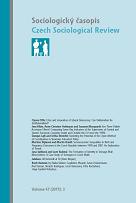Are There Visible Accession Effects? Comparing Some Key Indicators of the Trajectories of Central and Eastern European Countries Inside and Outside th
Are There Visible Accession Effects? Comparing Some Key Indicators of the Trajectories of Central and Eastern European Countries Inside and Outside th
Author(s): Jens Alber, Susanne Marquardt, Anne Christine HoltmannSubject(s): Social Sciences
Published by: AV ČR - Akademie věd České republiky - Sociologický ústav
Keywords: European Union; Eastern enlargement; neighbourhood policy; accession effects; Copenhagen criteria; positive and negative integration
Summary/Abstract: Comparing four groups of post-communist transition countries—those which became EU members, those with candidate status, and two groups which are considered mere partners with or without a future membership perspective—the authors examine to what extent there are visible accession effects. The basic assumption is that countries which were under the pressure of the Copenhagen criteria and under constant EU supervision should have developed more favourably than the others with respect to good governance, dynamic market economy growth, and public policies in line with the idea of a European social model. The empirical analysis seeks to clarify to what extent there were selection effects prior to EU candidacy, to what extent countries with and without a membership option diverged, and to what extent there was convergence within the groups of member states, of candidate countries and of other post-socialist countries. Accession effects are found to be more discernible in the fields of economic growth and of political democracy than in the fields of social cohesion and quality of life.
Journal: Sociologický časopis / Czech Sociological Review
- Issue Year: 47/2011
- Issue No: 03
- Page Range: 473-506
- Page Count: 34
- Language: English

